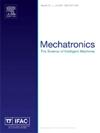考虑人类适应性的动力外骨骼无拐杖行走优化
IF 3.1
3区 计算机科学
Q2 AUTOMATION & CONTROL SYSTEMS
引用次数: 0
摘要
在使用动力外骨骼的无拐杖行走中,飞行员本能地使用上半身来适应运动并保持平衡,特别是在没有下肢感官反馈或外部稳定辅助的情况下。这些自我平衡的努力,通常涉及显著的头部和躯干运动,不仅增加了身体和认知负荷,而且降低了外骨骼的整体可用性。本研究提出了一种人类适应循环优化方法,该方法可以最大限度地减少对上半身自愿调整的需要,特别是头部运动。该方法旨在通过基于飞行员头部运动和压力中心(COP)建模的踝关节轨迹迭代优化,最大限度地减少飞行员的自主平衡,从而实现无拐杖行走。因此,本文提出的人类自适应环内优化最小化了飞行员自适应运动在人-机器人集成系统中没有反映出来的不稳定性,使脊髓损伤(SCI)患者能够在不使用拐杖的情况下以0.24 m/s的速度连续行走。这展示了一种有效的解决方案,可以在动力外骨骼中实现自然的、无拐杖的行走。本文章由计算机程序翻译,如有差异,请以英文原文为准。
Optimization of crutch-free walking for a powered exoskeleton considering human adaptation
In crutch-free walking with powered exoskeletons, pilots instinctively engage their upper body to adapt its motion and maintain balance, especially in the absence of lower-limb sensory feedback or external stabilizing aids. These self-balancing efforts, often involving significant head and trunk movement, not only increase physical and cognitive load but also reduce the overall usability of the exoskeleton. This study proposes a human-adaptation-in-the-loop optimization method that minimizes the need for voluntary upper-body adjustments, particularly head movement. This approach aims to enable crutch-free walking by minimizing the pilot’s voluntary balancing, achieved through the iterative optimization of ankle joint trajectory based on the modeling of the pilot’s head movements and the center of pressure (COP). As a result, the proposed human-adaptation-in-the-loop optimization minimized the instability caused by the pilot’s adaptation motion that is not reflected within the human–robot integrated system, enabling continuous walking for people with spinal cord injury (SCI) at a speed of 0.24 m/s without the use of crutches. This demonstrates an effective solution for achieving natural, crutch-free walking in a powered exoskeleton.
求助全文
通过发布文献求助,成功后即可免费获取论文全文。
去求助
来源期刊

Mechatronics
工程技术-工程:电子与电气
CiteScore
5.90
自引率
9.10%
发文量
0
审稿时长
109 days
期刊介绍:
Mechatronics is the synergistic combination of precision mechanical engineering, electronic control and systems thinking in the design of products and manufacturing processes. It relates to the design of systems, devices and products aimed at achieving an optimal balance between basic mechanical structure and its overall control. The purpose of this journal is to provide rapid publication of topical papers featuring practical developments in mechatronics. It will cover a wide range of application areas including consumer product design, instrumentation, manufacturing methods, computer integration and process and device control, and will attract a readership from across the industrial and academic research spectrum. Particular importance will be attached to aspects of innovation in mechatronics design philosophy which illustrate the benefits obtainable by an a priori integration of functionality with embedded microprocessor control. A major item will be the design of machines, devices and systems possessing a degree of computer based intelligence. The journal seeks to publish research progress in this field with an emphasis on the applied rather than the theoretical. It will also serve the dual role of bringing greater recognition to this important area of engineering.
 求助内容:
求助内容: 应助结果提醒方式:
应助结果提醒方式:


